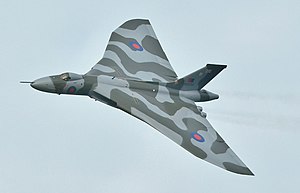| Avro Vulcan | |
|---|---|
 Avro Vulcan XH558 over Farnborough, 2015 | |
| General information | |
| Type | Strategic bomber |
| National origin | United Kingdom |
| Manufacturer | Avro Hawker Siddeley Aviation |
| Status | Retired |
| Primary user | Royal Air Force |
| Number built | 136 (including prototypes) |
| History | |
| Manufactured | 1956–1965 |
| Introduction date | September 1956 |
| First flight | 30 August 1952 |
| Retired | March 1984 (Royal Air Force) October 2015 (XH558) |
| Developed into | Avro Atlantic (proposed) |

The Avro Vulcan (later Hawker Siddeley Vulcan[1] from July 1963)[2] is a jet-powered, tailless, delta-wing, high-altitude, strategic bomber, which was operated by the Royal Air Force (RAF) from 1956 until 1984. Aircraft manufacturer A.V. Roe and Company (Avro) designed the Vulcan in response to Specification B.35/46. Of the three V bombers produced, the Vulcan was considered the most technically advanced, hence the riskiest option. Several reduced-scale aircraft, designated Avro 707s, were produced to test and refine the delta-wing design principles.
The Vulcan B.1 was first delivered to the RAF in 1956; deliveries of the improved Vulcan B.2 started in 1960. The B.2 featured more powerful engines, a larger wing, an improved electrical system, and electronic countermeasures, and many were modified to accept the Blue Steel missile. As a part of the V-force, the Vulcan was the backbone of the United Kingdom's airborne nuclear deterrent during much of the Cold War. Although the Vulcan was typically armed with nuclear weapons, it could also carry out conventional bombing missions, which it did in Operation Black Buck during the Falklands War between the United Kingdom and Argentina in 1982.
The Vulcan had no defensive weaponry, initially relying upon high-speed, high-altitude flight to evade interception. Electronic countermeasures were employed by the B.1 (designated B.1A) and B.2 from around 1960. A change to low-level tactics was made in the mid-1960s. In the mid-1970s, nine Vulcans were adapted for maritime radar reconnaissance operations, redesignated as B.2 (MRR). In the final years of service, six Vulcans were converted to the K.2 tanker configuration for aerial refuelling.
After retirement by the RAF, one example, B.2 XH558, named The Spirit of Great Britain, was restored for use in display flights and air shows, whilst two other B.2s, XL426 and XM655, have been kept in taxiable condition for ground runs and demonstrations. B.2 XH558 flew for the last time in October 2015 and is also being kept in taxiable condition. XM612 is on display at Norwich Aviation Museum.[3]
- ^ "Hawker Siddeley Vulcan B2". National Cold War Exhibition. Trustees of the Royal Air Force Museum. Archived from the original on 6 August 2020. Retrieved 24 July 2013.
- ^ "Hawker Siddeley Aviation Ltd." Flight, 29 August 1963, p. 342.
- ^ "City of Norwich Aviation Museum - Norfolk". City of Norwich Aviation Museum.